
Chickenpox booster shots were given to 53 students at Southside
Elementary School on Wednesday afternoon after the school was
closed last Friday as a precaution due to 11 cases reported there,
Southside Principal Eric Johnson said.
Chickenpox booster shots were given to 53 students at Southside Elementary School on Wednesday afternoon after the school was closed last Friday as a precaution due to 11 cases reported there, Southside Principal Eric Johnson said.
Johnson said there have been 11 cases in all at the school. Thirty one students have been sent home who had an apparent red dot appear, he said, because it’s better to be safe. Twenty of the cases were not the virus.
Sam Perez, health and human services project director for the county, said this isn’t usually the time of year to see many cases of the chickenpox. He said there also have been six cases of chickenpox at Cerra Vista Elementary School. The six kids who had it were all in the same classroom, she said, unlike at Southside where it was across the board.
Health Program Evaluator Steven VanTine said people often can get it from traveling between states or being exposed on a plane without knowing it, VanTine said.
VanTine said the school and health department got together within a week of the first sign of chickenpox there to conduct the booster shots.
“We really jumped on it,” VanTine said.
Students shouldn’t attend school if they experience the first signs of chickenpox to prevent further spread of the illness during the infectious period. Someone infected with chickenpox will remain contagious until all lesions are crusted over, Perez said.
Perez said chickenpox is spread through direct contact with oral and nasal lesion secretions or from airborne spread of the fluids from someone with the viral disease. It takes about a week for the contagious part to go away.
It takes 14 to 16 days to develop chickenpox symptoms after they are exposed to it, but can take up to 21 days, according to a press release from the Public Health Division. Perez said symptoms are usually a mild fever and the general sense of “not feeling well,” followed by a itchy rash that can sometimes form blisters.
The contagious period is one to two days before the rash starts and until all the sores are dry and crusted, which is usually five days after the rash starts, according to the press release. Perez said if someone scratches the chickenpox’s they can get scar’s. Someone can get a secondary infection if their fingernails aren’t clean and they scratch, Perez said.
More than 90 percent of cases are reported among people under the age of 15, according to the Center for Disease Control and Prevention Web site.
Perez said that children should receive a dose of the vaccine at the age of 1 and should get a booster shot between the ages of 4 and 5. Someone who gets the vaccine can still get infected with a breakout of chickenpox, but it’s usually a milder case, according to the county.
Health Officer Dr. Elizabeth Falade said there have been cases found where one dose doesn’t guarantee 100 percent prevention and she recommends a two-dose series for 100 percent coverage.
According to California School Immunization Law, a child must receive one dose of the Varicella vaccine or have had the illness in order to attend school.
Anyone who is unvaccinated without known immunity to chickenpox should receive the vaccine within three to five days of exposure to the virus to prevent or lessen it, according to the press release.









